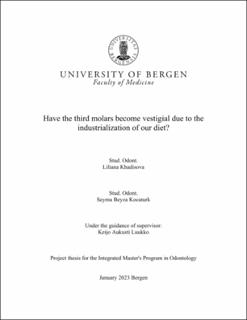| dc.contributor.author | Khadisova, Liliana Adamovna | |
| dc.contributor.author | Kocaturk, Seyma Beyza | |
| dc.date.accessioned | 2023-02-27T07:44:24Z | |
| dc.date.available | 2023-02-27T07:44:24Z | |
| dc.date.issued | 2023-01-30 | |
| dc.date.submitted | 2023-02-24T23:03:33Z | |
| dc.identifier.uri | https://hdl.handle.net/11250/3054044 | |
| dc.description.abstract | Human jaws have been proven to be subject to morphological changes through the course of evolution. The diet of the human species has evolved from tough and abrasive to soft and processed food. This is hypothesized to have had some consequences on the jaws and third molars in particular. This literary review aims to investigate the correlation between dietary habits and dysfunctionality of the third molars in light of the increased prevalence of third molar complications in recent human history and the evolution of diet. This is a literary review using PubMed, ResearchGate, and Google Scholar as core databases. Specific keywords were used to gather data for our search. The jaw of the human lineage appears to have gone through developmental and morphological changes concurrent with the dietary shift from tough and abrasive to soft and processed food. The available data suggests that in comparison with their ancestors, modern humans appear to experience more developmental and pathological complications with their third molars. Modern human dentitions are more overcrowded, and there are more complications associated with third molars than ever before recorded. In some cases, third molars fail to develop entirely, which is also known as agenesis. The changes in the dietary habits of the extinct hominins seem to have some correlation with the jaws of their successors having less room for third molars to develop and erupt into a well-aligned position in the dental arch. The data found in the present literary review study indicates that there have been evolutionary changes in development in the maxilla and mandible, and localization and development of third molars. These changes are hypothesized to have been a result of the changes in dietary habits and subsistence strategies throughout human evolution. | |
| dc.language.iso | eng | |
| dc.publisher | The University of Bergen | |
| dc.rights | Copyright the Author. All rights reserved | |
| dc.title | Have the third molars become vestigial due to the industrialization of our diet? | |
| dc.type | Master thesis | |
| dc.date.updated | 2023-02-24T23:03:33Z | |
| dc.rights.holder | Copyright the Author. All rights reserved | |
| dc.description.degree | Prosjektoppgave / Integrert masteroppgave | |
| dc.description.localcode | OD3PROSJ | |
| dc.description.localcode | MAOD-ODONT | |
| dc.subject.nus | 764106 | |
| fs.subjectcode | OD3PROSJ | |
| fs.unitcode | 13-19-0 | |
